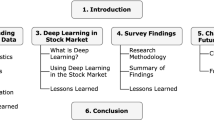Abstract
We apply the recurrent reinforcement learning method of Moody, Wu, Liao, and Saffell (1998) in the context of the strategic asset allocation computed for sample data from US, UK, Germany, and Japan. It is found that the optimal asset allocation deviates substantially from the fixed-mix rule. The investor actively times the market and he is able to outperform it consistently over the almost two decades we analyze.
Similar content being viewed by others
References
Barsky R.B., Juster F.T., Kimball M.S., Shapiro M.D. (1997). Preference parameters and behavioral heterogeneity. An experimental approach in the health and retirement study. Quarterly Journal of Economics 111: 537–579
van Binsbergen, J. H., Brandt, M. W. (2006). Solving dynamic portfolio choice problems by recursing on optimized portfolio weights or on the value function. Computational Economics, forthcoming.
Brandt M.W. (1999). Estimating portfolio and consumption choice: A conditional Euler equations approach. Journal of Finance 54, 1609–1646
Brandt M.W., Goyal A., Santa-Clara P., Stroud J.R. (2006). A simulation approach to dynamic portfolio choice with an application to learning about return predictability. Review of Financial Studies 18, 831–873
Brennan M.J., Schwartz E.S., Lagnado R. (1997). Strategic asset allocation. Journal of Economic Dynamics and Control 21(7): 1377–1403
Campbell J.Y., (2000). Asset pricing at the millenium. Journal of Finance 55(4): 1515–1567
Campbell J.Y., Andrew L., Craig Mc Kinley A. (1999). The econometrics of financial markets. Princeton, NJ, Princeton University Press
Campbell J.Y., Shiller R.J. (1988). The dividend price ratio and expectations of future dividens and discount factors. Review of financial studies 1, 195–228
Campbell J.Y., Viceira L.M. (2002). Strategic asset allocation. Oxford, Oxford University Press
Campbell J.Y., Viceira L.M. (1999). Consumption and portfolio decisions when expected returns are time-varying. Quarterly Journal of Economics 114, 433–495
Campbell J.Y., Viceira L.M. (2005). Strategic asset allocation for pension plans. forthcoming. In: Gordon Clark, Alicia Munnell, Michael Orszag (eds). Oxford handbook of pensions and retirement income.Oxford University Press, Oxford, pp: 5-7
Cochrane, J. H. (1991). Portfolio advice for a multifactor world, economic perspectives XXIII (3) Third quarter 1999 (pp. 59–78). Chicago: Federal Reserve Bank of Chicago.
Daniel K., Hirshleifer D., Subrahmanyam A. (1998). Investor psychology and security market under- and overreactions. Journal of Finance 53(6): 1839–1885
De Bondt W., Thaler R.H. (1985). Does the stock market overreact?. Journal of Finance 40(3): 793–805
Gallant A.R., Hansen L.P., Tauchen G. (1990). Using conditional moments of asset payoffs to infer the volatility of intertemporal marginal rates of substitution. Journal of Econometrics 45(1–2): 141–179
Fama E. (1998). Market efficiency, long-term returns, and behavioral finance. Journal of Financial Economics 49, 283–306
Friend M.E., Blume I. (1975). The Demand for risky assets. American Economic Review 65(5): 900–922
Malkiel B.G. (2003). The efficient market hypothesis and its critics. Journal of Economic Perspectives 17, 59–82
Merton R. (1969). Lifetime portfolio selection under uncertainty: The continuous-time case. Review of Economics and Statistics 51, 247–257
Moody J., Wu L., Liao Y., Saffell M. (1998). Performance functions and reinforcement learning for trading systems and portfolios. Journal of Forecasting 17, 441–470
Samuelson P.A. (1969). Lifetime portfolio selection by dynamic stochastic programming. The Review of Economics and Statistics 51(3): 239–246
Samuelson, P. A. (1991). Long-run risk tolerance when equity returns are mean regressing: Pseudoparadoxes and vindication of Businessman’s Risk, Brainard, Nordhaus, Watts (Eds.), Money, macroeconomics, and economic policy. Essay in Honor of James Tobin, (chap. 7, pp. 181–200). Newyork: MIT Press.
Shleifer A. (2000). Inefficient markets: An introduction to behavioral finance. Oxford, Oxford University Press
Wöhrmann, P. (2006). An axiomatic approach to prediction. University of Zurich.
Author information
Authors and Affiliations
Corresponding author
Rights and permissions
About this article
Cite this article
Hens, T., Wöhrmann, P. Strategic asset allocation and market timing: a reinforcement learning approach. Comput Econ 29, 369–381 (2007). https://doi.org/10.1007/s10614-006-9064-0
Received:
Accepted:
Published:
Issue Date:
DOI: https://doi.org/10.1007/s10614-006-9064-0




